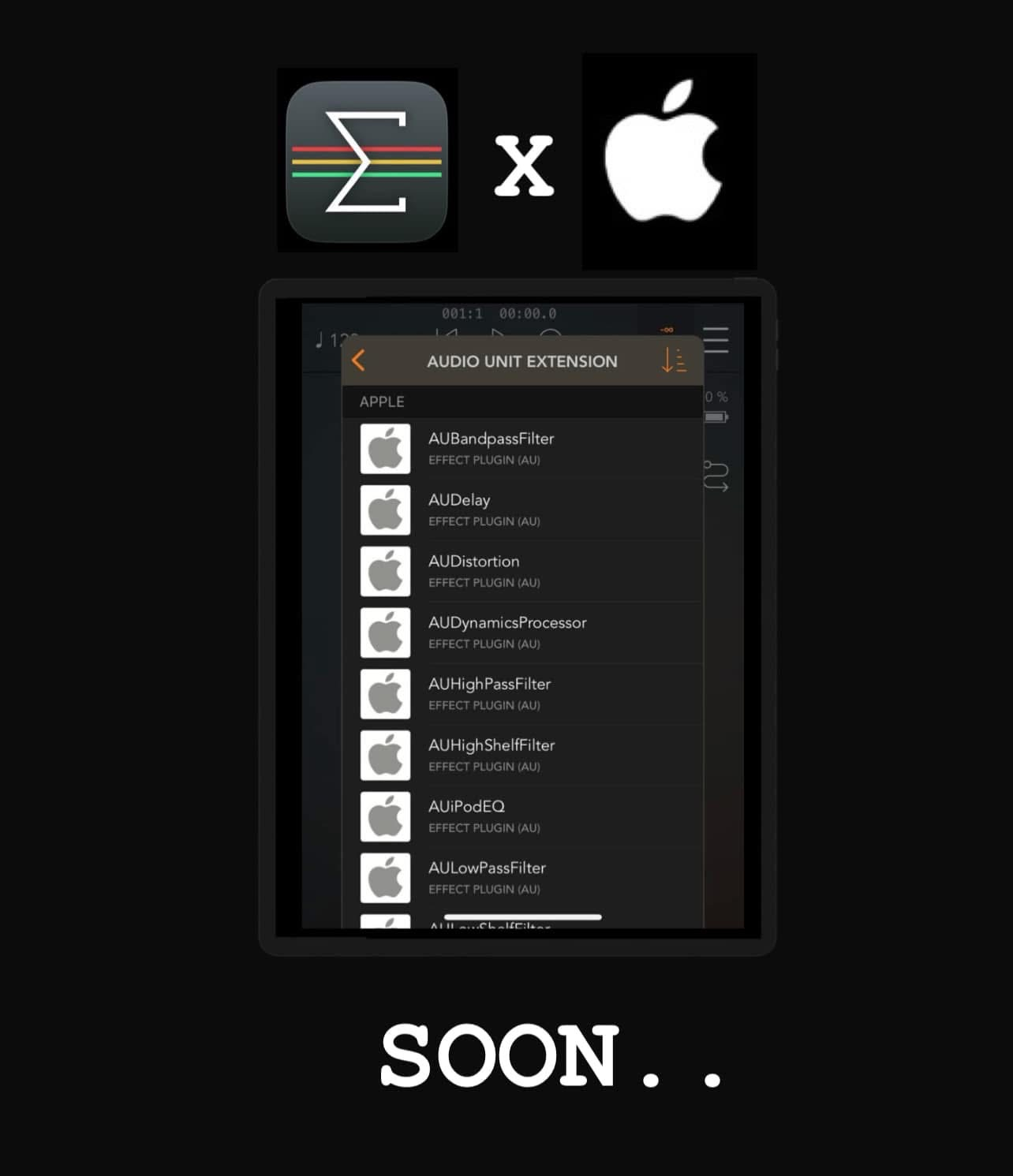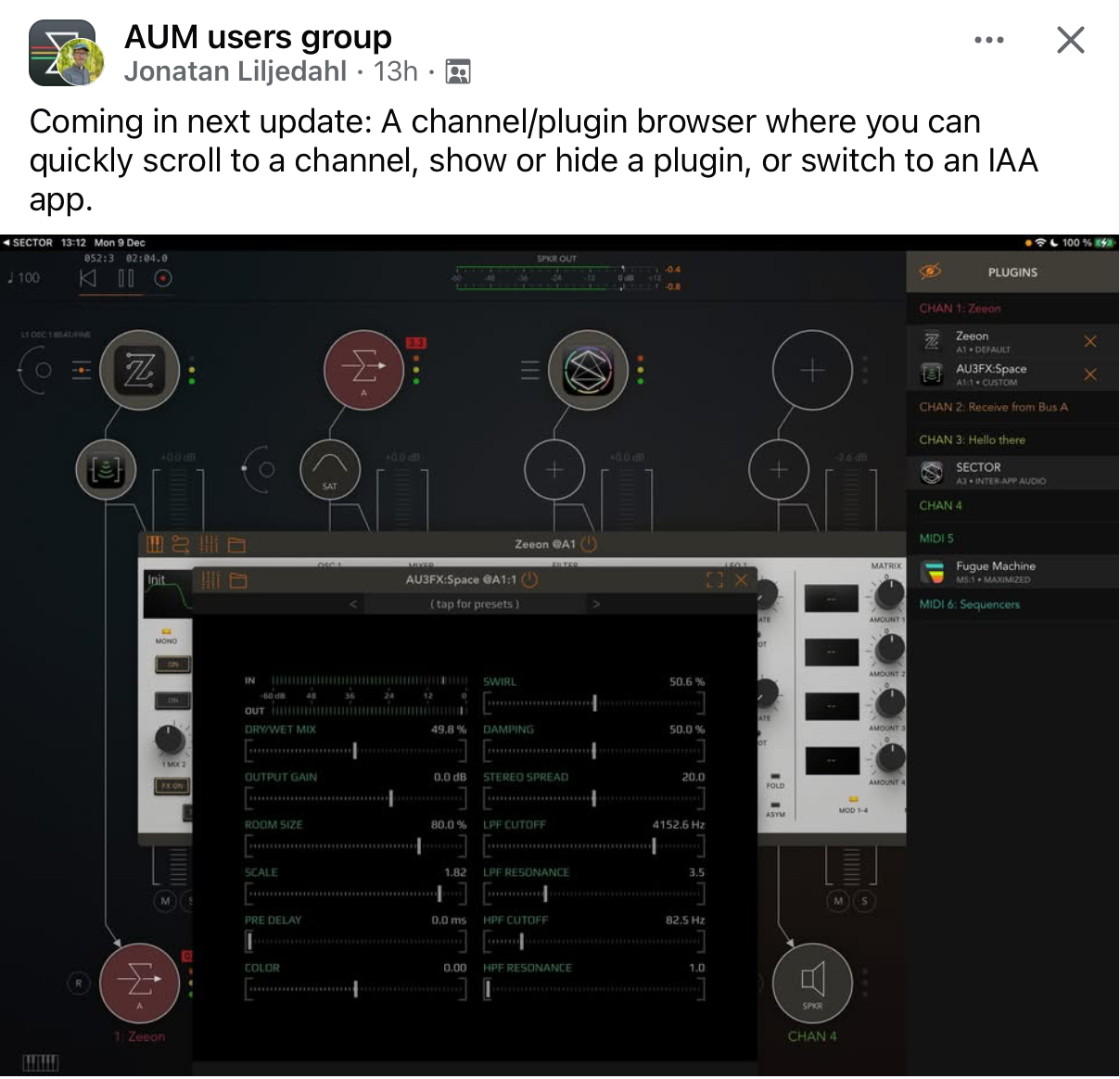Loopy Pro: Create music, your way.
What is Loopy Pro? — Loopy Pro is a powerful, flexible, and intuitive live looper, sampler, clip launcher and DAW for iPhone and iPad. At its core, it allows you to record and layer sounds in real-time to create complex musical arrangements. But it doesn’t stop there—Loopy Pro offers advanced tools to customize your workflow, build dynamic performance setups, and create a seamless connection between instruments, effects, and external gear.
Use it for live looping, sequencing, arranging, mixing, and much more. Whether you're a live performer, a producer, or just experimenting with sound, Loopy Pro helps you take control of your creative process.
Download on the App StoreLoopy Pro is your all-in-one musical toolkit. Try it for free today.
AUM to support all Apple AU effects

Just read this on Facebook..
Hope it’s legit..
AUM is already amazing .


Comments
Cool! I wonder what else is in this upcoming update?
(My wish is for one day being able to stack and hide sub channels and be able to expand/collapse this sub channel view)
Like Loopy Pros two level mixer in a way ? It's how I'm picturing your comment. Which would be great.
I love AUM but I'm confused about this news. I had podcasting editor app that had these exposed for years.
I hope there's more to it potentially paving a path for something bigger sooner.
That being said the app is still great. It doesn't show it's age like Audioshare and it's just so fun to get ideas going.
The next version also has something I've been wishing for...clock divisions...yay!
Is this like telling a specific plugin that the BPM is a fraction of the project’s BPM?
Yes...
Nice! I've pestered a few plugin devs for their own implementation of clock divisions so it's great to see this implemented at the host level
For Reals. Sweet.
On who's Facebook account was this?
I’m pretty certain it was posted by Jonatan in the AUM group a couple of days ago.
Another teaser from Jonatan on the FB AUM group:

Great - means it is for real.
Summoning @j_liljedahl . Curious to what he'll say here.
Curious to what he'll say here.
Hello everyone
Yeah, some of the things coming in the next update:
great! can't wait!
That clock divider/multiplier is hugh for me!
The navigator sounds a great idea too, as I often have to have multiple tiny windows open to get to apps quickly while jamming - hopefully this makes it easier to get to AuV3s super quick hence not having to leave them all tiny open windows!
Great! Thanks a lot!
Just one question, anything about multithread???
Call me "Jim the Summoner", lol.
All this sounds really awesome! Quite a few new useful features. Thanks man. How've you been?
Thanks man. How've you been?
The clock divider/multiplier is simple and brilliant.
Just saying.. just a simple ‘pin’… Thank you..
Windows Mode… Thanks..
Copy-pasted from my comment about this in the AUM Users Group on facebook:
I think there is some common confusion about the concepts here. AUM is already multithreaded, as most apps are more or less. First of all, any audio app is automatically multithreaded since the UI and the audio runs on separate threads, with different priorities. Also, on devices with multiple CPU cores, the operating system distributes the threads from all the running apps (including system stuff that runs in the background) across the available cores to balance the work and to only use the more power-hungry cores when needed (to save energy).
This means that even if you're using apps with "few" threads, you get benefits from multi-core devices, because the system has a higher chance of allocating a core to the audio thread that it can have more or less for itself.
What you are referring to is a multithreaded audio engine, which means that the app offloads some audio work to parallell threads, to run them simultaneously before joining the work at the end. Note that even in this case, the audio processing still ends in a single thread, because there is only one thread that actually outputs the audio to your audio interface. Multithreaded audio is about splitting up "sub tasks" of audio work, and then waiting for them to finish at the end of the render cycle to collect the work before outputting the result. This is suitable when there are many things running in parallell, without any inter-dependencies, like audio tracks in a timeline-editor-style DAW. As soon as you add a dependency between stuff, then it means we can't break it into two threads. I'm planning to add this to AUM in the future, but it means deciding where to split the work according to dependencies between audio channels (due to mixbusses, sends, MIDI routing, etc). There is also some overhead in the thread splitting and joining, so there is not automatically a performance gain just because we split the work. One has to find a good balance..
Another misconception is that only the Apple-silicon is multi-core. Even my old iPhone 7 is multi-core, even though it only has 2 cores.
In AUM, you can tap the DSP% meter, then go into Node Statistics, and at the bottom you'll see the CPU cores of your device and how the operating system is distributing the audio thread among the cores. On devices with more than 2 cores, the last 2 or so are often high-performance cores while the first ones are energy-efficient cores.
Thanks a lot @j_liljedahl for your precise explanation!
OK, then I mean Multithreaded audio!
In my experience with the iPad Air4, I´ve been using and experimenting extensively using mirack (that is not a timeline daw, but a "free" system/mixer as AUM) and the gain using multithreaded audio in real life, I mean using the same synths/fx as in an AUM session is roughtly 6x the amount. and thats a lot!
Didn´t know the technical background about how the audio is distributed but I can tell that when my project was about to explode (95% in AUM, and yes I mean audio dropouts and the core working at full speed) I was thinking in upgrade to a newer and more powerful iPad... Then I tried multithreaded audio and found that I can add more than five times the fx and synths without dropouts!
Now I have an ipad Pro M1 and plan to make the same comparisons. I´ll post the result here, but manwhile I bet the M1 in single threaded audio could load 3 times less synths and fx than the Air4 with multithreaded audio.
Multithreaded audio really is the killer host feature I'm looking for these days. Would save me $500+ on a new iPad if LP, Drambo or AUM implemented it as well as MiRack or Cubasis do..
Just bought miRack on a whim to see if I can make it work for me
@Goldiblockz : I don't know if this has changed, but It is my understanding that the implementations of multi-threaded audio in iOS DAWs comes at the expense of increased latency. This might not be an issue in mixing but would be an issue for realtime low-latency audio performance.
Perhaps, this isn't the case anymore but I recall one developer who was looking into it mention that the DAWs they looked at turned large buffers when multi-threaded audio is turned on.
@espiegel123 No extra latency with multithreaded audio in miRack! I use it for live play instruments and fx
Excellent news!
that is a massive difference and if transferable even partly to AUM would be a game changer for me. Overloaded cpu is easy to achieve on m1pro, which I partly got to solve that problem on 9th gen. It helped but wasn't a total game changer, and I don't think the 16gb has been of any benefit at all, M4 (can't afford anyway) will likely not be enough. What is the workflow like on Mirack? Can't see myself leaving AUM but the overload is so frustrating when using some high needy synths in my favourite app.
I’m already pushing high buffer sizes as is and I’m perfectly happy with my latency, would really appreciate some dsp/cpu wiggle room on top of it though. (A12X, so not exactly new hardware, I would love to see hardware stats on the loopy pro website or on the forum, akin to Steam user survey results so we can see what the majority of loopers are using. I hope Tasty Pixel has this information in the background at least from Apple!)
I believe it’s the highest requested Loopy Pro feature, even more so than MIDI loops. I think it has been for two years now.
"Overloaded cpu is easy to achieve on m1pro, which I partly got to solve that problem on 9th gen. It helped but wasn't a total game changer, and I don't think the 16gb has been of any benefit at all, M4 (can't afford anyway) will likely not be enough. "
If M1 and M4 models are falling to their knees, is it time for a shift in approach?
The anecdotes speak for themselves imo, I don't think it's snake oil. It seems to be a pretty consistent 2-3x increase in ability/workload on the lower end of things. I don't think we can expect instrument/effect developers to all start optimizing like Brambos unfortunately